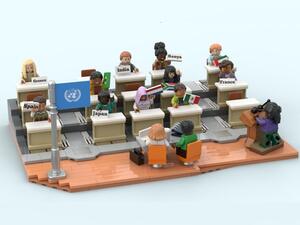'Refugees' and 'Migrants' – Frequently Asked Questions (FAQs)
'Refugees' and 'Migrants' – Frequently Asked Questions (FAQs)

A refugee mother and her two children rest after arriving by boat on the island of Lesvos.
'Refugees' and 'Migrants'
Frequently Asked Questions (FAQs)
1. Are the terms ‘refugee’ and ‘migrant’ interchangeable?
No. Although it is becoming increasingly common to see the terms 'refugee' and 'migrant' used interchangeably in media and public discussions, there is a crucial legal difference between the two. Confusing them can lead to problems for refugees and asylum-seekers, and for States seeking to respond to mixed movements, as well as to misunderstandings in discussions of asylum and migration.
2. What is unique about refugees?
Refugees are specifically defined and protected in international law. Refugees are people outside their country of origin because of feared persecution, conflict, violence, or other circumstances that have seriously disturbed public order, and who, as a result, require ‘international protection’. Their situation is often so perilous and intolerable, that they cross national borders to seek safety in nearby countries, and thus become internationally recognized as ‘refugees’ with access to assistance from states, UNHCR, and relevant organizations. They are so recognized precisely because it is too dangerous for them to return home, and they therefore need sanctuary elsewhere. These are people for whom denial of asylum has potentially deadly consequences.
3. How are refugees protected under international law?
The specific legal regime protecting the rights of refugees is referred to as ‘international refugee protection’. The rationale behind the need for this regime lies in the fact that refugees are people in a specific predicament which calls for additional safeguards. Asylum-seekers and refugees lack the protection of their own country.
Article 14 of the Universal Declaration of Human Rights asserts the right of everyone to seek and enjoy asylum. However, no clear content was given to the notion of asylum at the international level until the 1951 Convention related to the Status of Refugees [the ‘1951 Convention’] was adopted, and UNHCR was tasked to supervise its implementation. The 1951 Convention and its 1967 Protocol, as well as regional legal instruments, such as the 1969 OAU Convention Governing the Specific Aspects of Refugee Problems in Africa, are the cornerstone of the modern refugee protection regime. They set forth a universal refugee definition and incorporate the basic rights and obligations of refugees.
The provisions of the 1951 Convention remain the primary international standard against which any measures for the protection and treatment of refugees are judged. Its most important provision, the principle of non-refoulement (meaning no forced returns) contained in Article 33, is the bedrock of the regime. According to this principle, refugees must not be expelled or returned to situations where their life or freedom would be under threat. States bear the primary responsibility for this protection. UNHCR works closely with governments, advising and supporting them as needed, to implement their responsibilities.
4. Does the 1951 Convention need to be revisited?
The 1951 Convention and its 1967 Protocol have saved millions of lives and as such are among the key human rights instruments that we rely upon today. The 1951 Convention is a milestone of humanity developed in the wake of massive population movements that exceeded even the magnitude of what we see now. At its core, the 1951 Convention embodies fundamental humanitarian values. It has clearly demonstrated its adaptability to changing factual circumstances, being acknowledged by courts as a living instrument capable of affording protection to refugees in a changing environment. The greatest challenge to refugee protection is most certainly not the 1951 Convention itself, but rather ensuring that states comply with it. The real need is to find more effective ways to implement it in a spirit of international cooperation and responsibility-sharing.
5. Can ‘migrant’ be used as a generic term to also cover refugees?
A uniform legal definition of the term ‘migrant’ does not exist at the international level.[1] Some policymakers, international organizations, and media outlets understand and use the word ‘migrant’ as an umbrella term to cover both migrants and refugees. For instance, global statistics on international migration typically use a definition of ‘international migrant’ that would include many asylum-seekers and refugees.
In public discussion, however, this practice can easily lead to confusion and can also have serious consequences for the lives and safety of refugees. ‘Migration’ is often understood to imply a voluntary process, for example, someone who crosses a border in search of better economic opportunities. This is not the case for refugees, who cannot return home safely, and accordingly are owed specific protections under international law.
Blurring the terms ‘refugees’ and ‘migrants’ takes attention away from the specific legal protections refugees require, such as protection from refoulement and from being penalized for crossing borders without authorization in order to seek safety. There is nothing illegal about seeking asylum – on the contrary, it is a universal human right. Conflating ‘refugees’ and ‘migrants’ can undermine public support for refugees and the institution of asylum at a time when more refugees need such protection than ever before.
We need to treat all human beings with respect and dignity. We need to ensure that the human rights of migrants are respected. At the same time, we also need to provide an appropriate legal and operational response for refugees, because of their particular predicament, and to avoid diluting state responsibilities towards them. For this reason, UNHCR always refers to ‘refugees’ and ‘migrants’ separately, to maintain clarity about the causes and character of refugee movements and not to lose sight of the specific obligations owed to refugees under international law.
6. Do all migrants really always ‘choose’ to migrate?
The factors leading people to move can be complex. Often the causes are multi-faceted. Migrants may move across international borders to improve their lives by finding work, or in some cases for education, family reunion, or other reasons. People may also move to alleviate significant hardships that arise from natural disasters, famine, or extreme poverty. Those who leave their countries for these reasons would not usually be considered refugees under international law.
7. Don’t migrants also deserve protection?
The reasons why migrants may leave their countries are often compelling, and finding ways to meet their needs and protect their human rights is important. Migrants—including those in irregular situation—are protected by international human rights law. This protection derives from their fundamental dignity as human beings.[2] For some, failure to accord them human rights protection can have serious consequences. It may result in human rights violations, such as serious discrimination; arbitrary arrest or detention; or forced labour, servitude, or highly exploitative working conditions.
In addition, some migrants, such as unaccompanied or separated migrant children, or migrants who become victims of trafficking or are otherwise in a situation of vulnerability, may have specific needs for assistance, and have the right to have those needs met. UNHCR fully supports approaches to migration management that respect the human rights of all people on the move.
8. Are refugees ‘forced migrants’?
The term ‘forced migration’ is sometimes used by social scientists and others as a general, open-ended term that covers many kinds of displacement or involuntary movement—both across international borders and inside a single country. For example, the term has been used to refer to people who have been displaced by environmental disasters, conflict, famine, or large-scale development projects.
‘Forced migration’ is not a legal concept, and similar to the concept of ‘migration’, there is no universally accepted definition. It covers a wide range of phenomena. Refugees, on the other hand, are clearly defined under international and regional refugee law, and states have agreed to a well-defined and specific set of legal obligations towards them. Referring to refugees as ‘forced migrants’ shifts attention away from the specific needs of refugees and from the legal obligations the international community has agreed upon to address them. To prevent confusion, UNHCR avoids using the term ‘forced migration’ to refer to refugee movements and other forms of displacement.
9. So what is the best way to refer to mixed groups of people on the move that include both refugees and migrants?
UNHCR’s preferred practice is to refer to groups of people travelling in mixed movements as ‘refugees and migrants’.[3] This is the best way to allow for acknowledgement that all people on the move have human rights which should be respected, protected, and fulfilled; and that refugees and asylum-seekers have specific needs and rights which are protected by a particular legal framework.
Sometimes in policy discussions, phrases like ‘mixed movements’, ‘mixed flows’ or ‘composite movements’ are used to refer to the phenomenon of refugees and others on the move (including migrants, who may be in situations of vulnerability) travelling side-by-side along the same routes, using the same facilitators. ‘Mixed migration’ has also been used this way, but has sometimes been a source of confusion and is best avoided.
The term ‘mixed migrant’, which has been used by some as a shorthand way of referring to a person travelling in a mixed movement whose individual status is unknown or who may have multiple, overlapping reasons for moving, is unclear. It can cause confusion and mask the specific needs of refugees and migrants. It is not recommended.
10. What about refugees who leave one host country and enter another? Aren’t they actually best described as ‘migrants’ if they travel onward from the first country they stayed in?
A refugee does not cease to be a refugee or become a ‘migrant’ simply because they leave one host country to travel to another. A person is a refugee because of the lack of protection by their country of origin. Moving to a new country of asylum does not change this, so it does not affect a person’s status as a refugee. A person who meets the criteria for refugee status remains a refugee, regardless of the particular route they travel in search of protection or opportunities to rebuild their life, and regardless of the various stages involved in that journey.
UNHCR, 15 March 2016. Rev 30 August 2018.
[1] The 1990 UN Convention on the Protection of the Rights of All Migrant Workers and Members of their Families defines the term ‘migrant worker’. See also Article 11 of the 1975 ILO Convention Concerning Migrations in Abusive Conditions and the Protection of Equality of Opportunity and Treatment of Migrant Workers (No. 143) and of the 1979 ILO Migration for Employment Convention (No. 97); as well as Article 1 of the 1977 European Convention on the Legal Status of Migrant Workers.
[2] For example, the Universal Declaration of Human Rights; the International Covenant on Civil and Political Rights; and the International Covenant on Economic, Social and Cultural Rights; as well as other important international and regional treaties, recognize that all people, including migrants and refugees, have human rights.
[3] This reflects notably the language used by the UN General Assembly in the landmark New York Declaration for Refugees and Migrants 3 October 2016, A/RES/71/1, www.refworld.org/docid/57ceb74a4.html.









